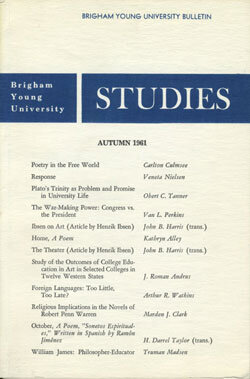The Theater
Article
Contents
(—The second of two articles by Henrik Ibsen on the nature and function of art, being an article written by Ibsen in his younger years when he was a reporter on his friend’s not too successful paper, Manden—when his wages for writing theatrical reviews was only a free pass to the plays. Written on May 25, 1851, the article was perhaps intended for that periodical, but it did not appear in print until it was published in Ibsen’s posthumous papers. Translated by John B. Harris.)
“How was William Tell?” I heard one student ask another after the performance of that opera.
“Excellent! The music is really outstanding.”
“And the libretto?”
“Oh well, there isn’t anything outstanding about the libretto—but in opera, the libretto is merely a tributary element.”
This line of reasoning is not at all uncommon; most people can remember either having used it themselves or having heard it used by others. The so-called appreciators of music are particularly fond of expressing themselves in this way, because it is usually they who consider opera as a mixture of two separate entities, music and text, in which, according to them, the one can perform its function completely even though the other is somewhat less than successful. Even real artists subscribe to this view, so it is therefore not unusual to hear a complete opera presented in a concert hall. Nothing can be more warped than such a concept of the purpose of operatic music, and I must, therefore, beg permission to dwell a bit on this subject.
Opera is that dramatic art form which, through a plastic1-musical medium, reproduces reality in an ideal picture. Consequently, this medium is, in its very basis, a composition of two elements, of which one alone is insufficient for the fulfillment of the intended goal. Each revelationary form in the arts has its boundaries, beyond which its power has not the capacity to stretch. Now music is basically of a lyrical, whereas the plastic art form is basically of an epic nature; but the opera is a unity of both and cannot, consequently, reveal itself through a medium whereof one element is missing.
The complete fulfillment of operatic music lies, therefore, precisely in its inability in and of itself to express the composer’s creative thoughts, just as the libretto’s fulfillment lies in the fact that it is not complete so long as it is not expressed through the unity of music and the plastic form. The most heartfelt harmony must thus take place between the music and the text: music is the soul of opera, the text its concrete form by which it is bound together, so that when in opera we find ourselves in the realm of the ideal, we demand a complete cooperation between content and form. Because music in the opera is characterized as content (not as form), it must be admitted that it must negate its won existence when it strives to become objectified of and by itself. Certainly a content without form is, in reality, merely an empty abstraction. The very existence of operatic music thus ceases when it is presented out of the theater, in that it strives to create of itself a self-sufficient entity.
Therefore, when the “appreciators of music” say that they prefer to sit with their eyes closed during the performance so that they might not be distracted in their appreciation of the music, they do so either for affectation or because their statement is founded upon a total miscomprehension of the meaning of operatic music. This sort of thing is possible in a concert hall; truly, here the presentation is immaterial. The music is, in and of itself, everything. But that is not the case in opera where music, as content, is experienced primarily through the medium of the plastic form.
It will hereby be perceived that that view which holds that the plot in an opera is to be regarded of secondary significance proclaims a completely erroneous understanding of what, precisely, an opera has to say. Any singer who does not have acting talent is unqualified to appear in an opera, for it is only through the dramatic that he can make understandable the poetry of music and let its thoughts express themselves.
Notes
Henrik Ibsen, Samlede Verker, eds. Francis Bull, Halvdan Koht, Didrik Arup Seip (20 vols., Hundredaarsutgave; Oslo: Gyldendal Norsk Forlag, 1928–1952), 15:66–68.
1. In this article, Ibsen uses the term “plastic art” in a most liberal application, using it to refer to any visual art—hence, acting.
- Poetry in the Free World
- Response [to Carlton Culmsee]
- Plato’s Trinity as Problem and Promise in University Life
- The War-Making Power: Congress vs. the President
- Ibsen on Art
- The Theater
- Study of the Outcomes of College Education in Art in Selected Colleges in Twelve Western States
- Foreign Languages: Too Little, Too Late?
- Religious Implications in the Novels of Robert Penn Warren
- William James: Philosopher-Educator
Articles
Purchase this Issue
Share This Article With Someone
Share This Article With Someone
Home
Print ISSN: 2837-0031
Online ISSN: 2837-004X


